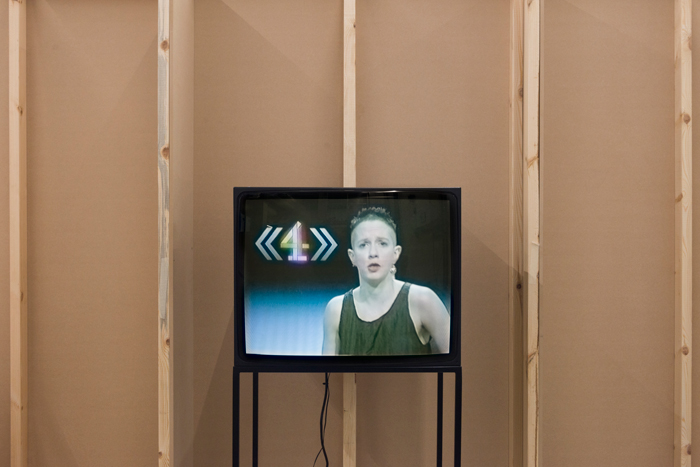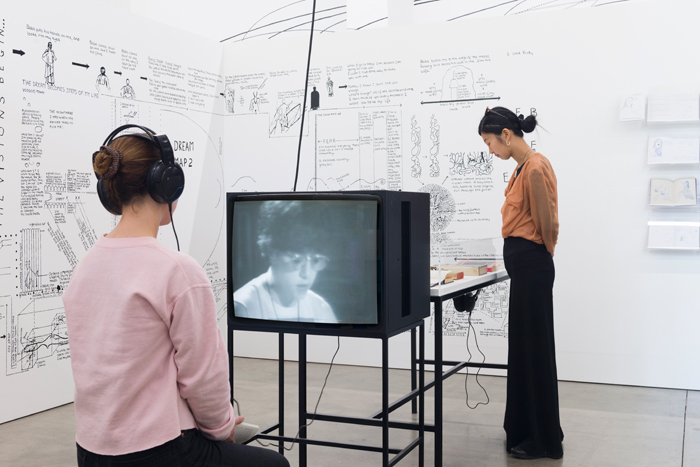It’s hard to pinpoint exactly when Acker was reborn as the artworld’s favourite sex-positive feminist. When about eight years ago I attempted to read every book she ever published as part of research for a PhD, Acker was an almost forgotten relic of the worst kind of postmodernism, remembered, if at all, as a cautionary tale of overdosing on Foucault and believing that everything, even cancer medication, is an instrument of ‘power-knowledge’. By the time I finished, I wasn’t sure if the impression of rereading the same texts was a product of my own boredom or the fact that, by the end of her career, Acker was plagiarising herself. But I did feel that a bored confusion was just the kind of response she would want to elicit in anyone seeking to embalm her in literary history.
Two books have played a role in her recent critical and – relatively speaking – popular revival: Chris Kraus’s After Kathy Acker (2017, reviewed here), a biography that barely disguised its distaste for the subject, and Olivia Laing’s Crudo (2018), which negotiated the narrator’s ambivalence about marrying into the British establishment by appropriating the persona of ‘Kathy Acker’. That these books were about Acker as an individual, rather than Acker’s work, provides a clue to why the artworld seems more obsessed with Acker’s persona than with Acker’s writings. Why get to grips with some frequently bleak and rebarbative ideas about sex, violence and the pleasure that comes from domination, when you can just as easily signal your sexual dissidence by dropping knowledge about Acker’s scandalous life? Did you know she was a stripper?
I, I, I, I, I, I, I, Kathy Acker at the ICA is another instance of treating knowledge of Acker’s life as substitute for her work. It is curating as hagiography, dedicated to convincing you of the art-historical significance of Kathy Acker. Downstairs, a wall displays a giant timeline charting the publication of her works, while plywood walls create a labyrinthine maze that runs up onto a second floor, stocked with video screens and vitrines containing her manuscripts for Great Expectations (1982), or her copies of books like Julia Kristeva’s Powers of Horror: An Essay on Abjection (1980), complete with Acker’s handwritten notes.
This show is another instance of treating knowledge of Acker’s life as substitute for her work. It is curating as hagiography
This curatorial technique – suggesting that every scrap of writing is a unique trace of Acker’s literary genius – is jarring in the context of a writer who spent a career attacking notions of artistic originality and authorial unity. ‘I knew I wanted to plagiarise,’ Acker once explained, ‘to see if, rather than trying to integrate the “I”, if you could dis-integrate it and find a more comfortable way of being.’ It comes down, she said, to the fact that ‘I don’t like the idea of originality’. The extracts from her work displayed in huge texts on the gallery walls invite us, in contrast, to ponder the originality of texts like this rip-off of Rimbaud: ‘I’ve been so fucking patient / That I’ve forgotten / Reality: / How bad he treated me.’ If these displays don’t convince us of Acker’s facility with rhyme and metre, they do prove the truth of her admission that: ‘I honestly thought I was writing the most unreadable stuff around’.
The exhibition is not totally disloyal to Acker’s ideal of disintegrated authorship. It also aims to show her affinities with other artists and writers, some from her own lifetime, but mostly those working today. Some of these connections make sense, albeit in a very literal way, as in Every Ocean Hughes’s Untitled (David Wojnarowicz project) (2001–07), a series of self-portraits of the artist in a Wojnarowicz mask. Overall, the curators present her work as having its greatest contemporary influence on artists and writers who work with the aesthetics and discourses of queerness: Candice Lin and Patrick Staff’s Hormonal Fog Study (2016–19), a device for distributing hormones in the air; Jamie Crewe’s Pastoral Drama (2018), a retelling of the story of Orpheus and Eurydice in stop-motion animation. Writers like Isabel Waidner and D. Mortimer are certainly innovative figures, and they are committed to working outside both commodity capitalism and the imaginative world of heterosexuality, yet these are two things that Acker showed little interest in challenging.
Situating Acker within a lineage of queer artists is odd because she was clear on the kind of art with which she felt her greatest affinity. ‘When I did Don Quixote,’ she said, ‘what I really wanted to do was a Sherrie Levine painting. I’m fascinated by Sherrie’s work.’ But an exhibition considering Acker within the legacy of appropriation would force us to see her in light of Levine’s 2011 admission that ‘we didn’t know the neo-avant-garde of the 80s would be used like it was to provide coverfire for Reaganomics,’ or shadowed by Richard Prince’s sale – then disavowal – of a photograph of Ivanka Trump’s Instagram. The complicity between appropriation and commodification is one legacy of Acker’s practice today, and it is telling that this legacy – disenchanting but historically informative – has been shunned in favour of a vague curatorial haze of liberating queerness.


The framing of Acker as somehow queer is doubly odd in that it occludes what this exhibition reminds us is the source of Acker’s greatest insights as well as her greatest limitation: her single-minded obsession with bourgeois heterosexuality. One wall text shows that from the beginning of her career, in Childlike Life of the Black Tarantula (1973), she was creating a mythology wherein ‘I [began] to live solely according to my desires’. Nowhere are these desires better encapsulated than in one of the dream maps reproduced on another wall: ‘I want to be the mermaid, the seducer of men, but I’m not’. In that dream map, for all of the polymorphous physicality of characters’ bodies, the object of her sexual desire, as it is in all her work, is the ejaculating penis.
There is no greater document of the terrifying claustrophobia of this kind of heterosexuality than The Blue Tape (1974), a video of Acker and Alan Sondheim discussing their relationship. “Power in relationships”, Acker says at one point, “is giving sexual pleasure.” Acker wanted to have that power, not to undo the system that makes power the only mechanism through which men and women can desire one another. Across the exhibition, we see no women as objects of desire – apart from Acker herself, posing naked for Sondheim’s gaze; we see no models of kinship between women and men outside of heterosexuality; just the fantasy of Acker as Pussy, King of the Pirates (1996), outside all social bonds and free to make her own desire the law.
This is the Acker that even this exhibition cannot repress. As I left, I passed one video screen showing Acker’s vagina while she masturbated, and another where Acker, shaven-headed and pierced, read one of her pirate stories for Channel 4: “Mary Read fell in love with a real man. I make my own laws, I make my own sexuality.” Acker didn’t want men to love her; I’m not sure she even cared if they liked her. She wanted to create her own body, pierced and bald and muscled, and to bend men’s desire to that creation. Kathy Acker, quite simply, wanted to fuck men and to write about fucking men, over and over, in the selfish pleasure of repetition. That women like this are still something to be embarrassed about, to be buried under the fog of a desexualised notion of queerness, is a true lesson of her revival, of which this exhibition is the guilty culmination.
I, I, I, I, I, I, I, Kathy Acker, Institute of Contemporary Arts, London, 1 May – 4 August 2019
Online exclusive published on 2 August 2019
